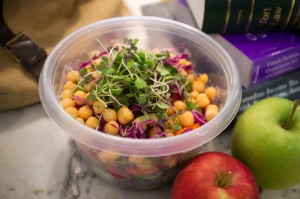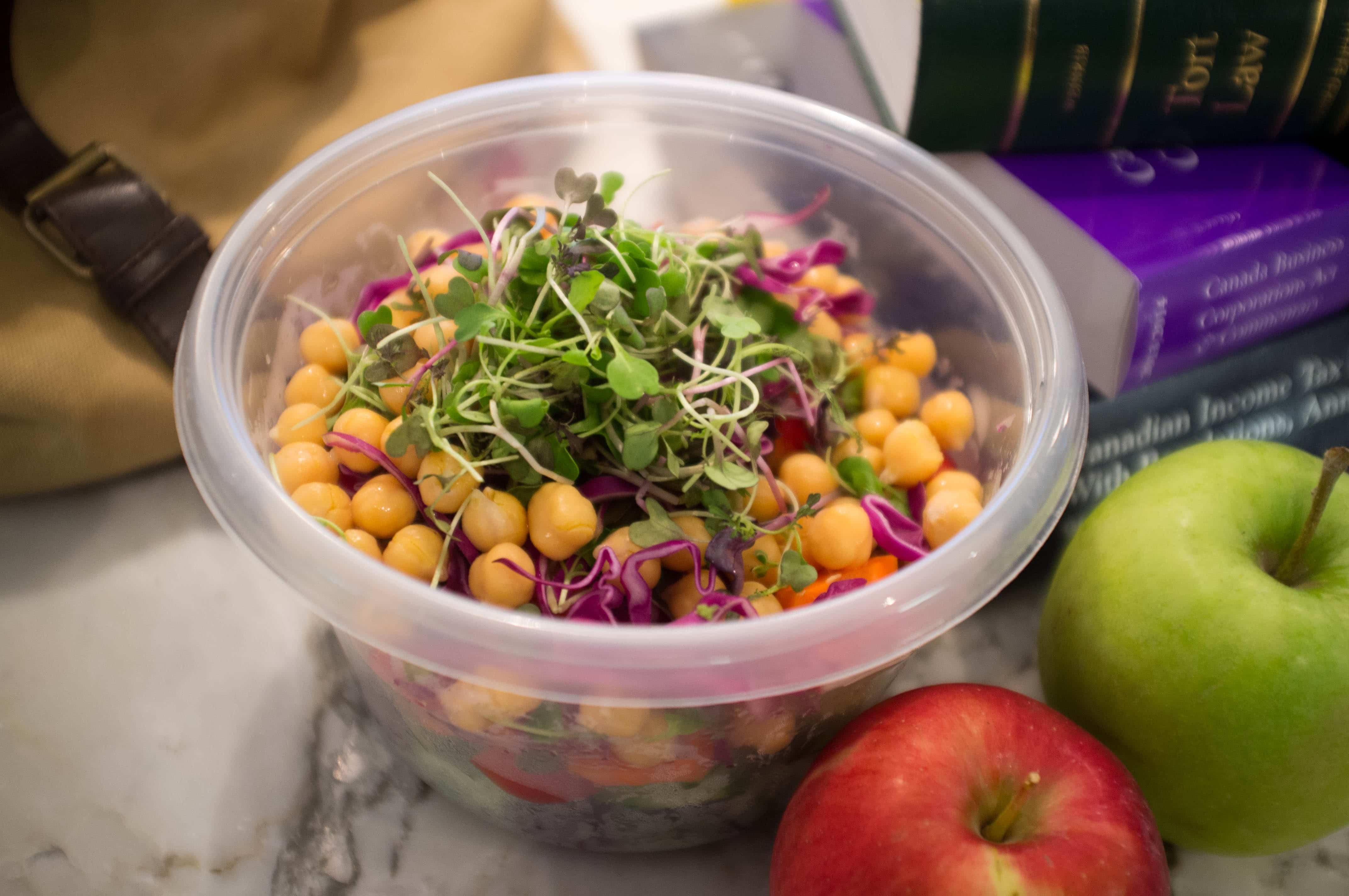I love salad. But bringing a salad for lunch can be messy. Who wants to eat soggy tomatoes, wilted lettuce, cucumbers that don’t crunch, and dressing that leaks all over your knapsack? Not me. Is there a way to bring a fresh salad for lunch, while avoiding these disastrous consequences?
 There is. I have tried salad dressing on the side, salad dressing in a bag, salad dressing mixed in, and no salad dressing at all. I did give in to pizza once, but I missed my daily greens. So let me share some general tips, a step-by-step guide, and a simple salad recipe that will get you on your way to packing the perfect lunchtime salad.
There is. I have tried salad dressing on the side, salad dressing in a bag, salad dressing mixed in, and no salad dressing at all. I did give in to pizza once, but I missed my daily greens. So let me share some general tips, a step-by-step guide, and a simple salad recipe that will get you on your way to packing the perfect lunchtime salad.
General Tips
- Pack your salad in a Tupperware with a lid that fits.
- Pack your salad items from heaviest to lightest. Heavier items (chopped veggies) should go on the bottom of your Tupperware, and lighter items (the lettuce) should go on top.
- Pour the dressing (about 2-3 tablespoons) on the bottom of the container, and then load the veggies on top. When you are ready to eat, simply shake and your salad is dressed.
Step 1: The Base
Choosing the base of your salad is the most important step. The base that you choose will impact the general sogginess factor (GSF) of your salad (see Figure 1). Below is a chart that will help you see how some different bases stand up for long periods of time.
At the high sogginess end are mixed greens and romaine lettuce. These are very susceptible to sogginess. If you use them, you must place them on top of your cut vegetables. Kale, on the other hand, is tough: you can mix and dress your salad in the morning, and it will stay crunchy throughout the day. On the far right are grains (quinoa, rice, etc.) and vegetables.

Step 2: The Veggies
The next step is to choose your veggies. Here are some ideas:
- Carrots
- Celery
- Cucumbers
- Peppers
- Radishes
- Purple Cabbage
- Radicchio
- Tomatoes
- Red onion (warning: may cause bad breath in afternoon)
- Corn
- Sprouts (alfalfa sprouts, sunflower sprouts)
- Parsnips
- Beets
- Green beans
Step 3: The “Protein”
Your salad needs energy. If you have some leftover chicken or meat, throw that in. Here are some vegetarian options:
- Avocado: This is my all-time favourite. Avocado makes a salad creamy and filling. Make sure your avocado is ripe. I usually buy a lot of avocados in advance and leave them on my counter to ripen.
- Tofu: Cut into small cubes.
- Chickpeas & beans: These are delicious and filling. Make sure to drain and rinse well.
- Cooked vegetables: I sometimes add in cooked potatoes or sweet potatoes.
- Hard-boiled egg: A great source of protein and keeps you full for the afternoon.
- Nuts and seeds: I love sprinkling pumpkin and sunflower seeds on my salads. Walnuts, shaved almonds, and hazelnuts are also good.
- Cheese: Goat’s milk or feta.
Step 4: Fun Extras
Sometimes, you need a little something extra to keep your salad exciting. To mix things up, try one or more of the following:
- Fruit (dried): Cranberries, currants, cherries, etc.
- Fruit (fresh): Pears, grapes, honey crisp apples, etc.
- Olives, sundried tomatoes, roasted red peppers, marinated artichokes
- Hemp hearts
Step 5: The Dressing
Making your own salad dressing is really simple. See the recipe below.
Simple Salad Recipe
Serving Size: 1 lunch-time salad (you can easily double this recipe)
Ingredients:
- 1-2 cups of mixed greens
- 1 carrot, chopped
- 1 baby cucumber, chopped
- Handful of cherry tomatoes
- ¼ cup of purple cabbage, sliced thin
- ½ avocado, diced
- ¼ cup chickpeas
- Handful of pumpkin seeds and sunflower seeds
- Sprinkle of dried cranberries
Simple Salad Dressing:
Make a large batch and use for salads all week. This will make enough dressing for 4 lunchtime salads.
Ingredients:
- 1 teaspoon Dijon mustard
- 1 teaspoon minced fresh garlic
- 2 tablespoons red wine vinegar
- 1 tablespoon honey
- 1 tsp salt
- ½ tsp freshly ground black pepper
- ½ cup good olive oil (or more if needed)
Directions:
- In a small bowl, whisk together the mustard, garlic, vinegar, 1 teaspoon salt, and ½ teaspoon pepper.
- While whisking, slowly add the olive oil until the vinaigrette is emulsified.
- Taste and adjust seasonings.






